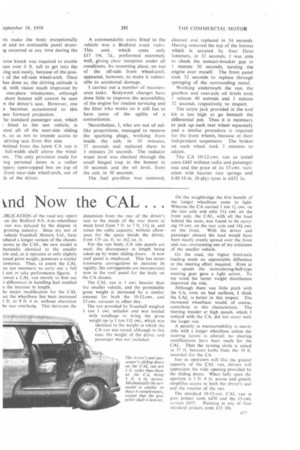uld Now the CAL . . .
Page 87

If you've noticed an error in this article please click here to report it so we can fix it.
JBLICAT1ON of the road test report on the Bedford 8-ft. 6-in.-wheelbase van was delayed by the dispute in printing industry. Since my test of vehicle Vauxhall Motors, Ltd., have aduced a longer version of the chassis. .nown as the CAL, the new model is hanically identical to the smaller icle and, as it operates at only slightly eased gross weight, possesses a similar Ormance. Thus, to assess the CAL 'as not necessary to carry out a full test or take performance figures. I -owed a CAL van merely to find out t differences in handling had resulted n the increase in length.
he major modification for the CAL la the wheelbase has been increased I. ft. to 9 ft. 6 in, without alteration he rear overhang. This increases the dimension from the rear of the driver's seat to the inside of the rear doors at waist level from 7 ft. to 7 ft. 11+ in. and raises the cubic 'capacity, without allowance for the space beside the driver, from 135 Cu. ft. to 162 cu. ft.
For the van body, CA side panels are used; the discrepancy in length being taken up by wider sliding doors. A new roof panel is employed. This has seven transverse corrugations to increase its rigidity. Six corrugations are incorporated now in the roof panel for the body on the CA chassis.
The CAL van is 1 cwt. heavier than the smaller vehicle, and the permissible gross weight is increased by a similar amount for both the 10-12-cwt. and 15-cwt. versions to offset this.
The van provided by Vauxhall weighed
1 ton I cwt. unladen and was loaded
with sandbags to bring the gross
weight up to 1 ton 13+ cwt., which was identical to the weight at which the CA van was tested. although in this case, the weight of the driver and passenger was not included. On the weighbridge the tirst benefit of the longer wheelbase came to light. Whereas the CA carried 1 ton 11 cwt. on the rear axle and only Ill cwt. on the front axle, the CAL, with all the load behind the seats, was found to be carrying 19 cwt. on the rear axle and 14+ cwt. on the front. With the driver and passenger aboard the load would have been nearly evenly spread over the front and rear, overcoming one of my criticisms of the smaller vehicle.
On the road, the higher front-axle loading made no appreciable difference to the steering effort required. Even at low speeds the recirculating-ball-type steering gear gave a light action. To my mind the better weight distribution improved the ride.
Although there was little pitch with the CA, even on bad surfaces, I think the CAL is better in this respect. The increased wheelbase would, of course, contribute to this characteristic. The steering wander at high speeds. which I noticed with the CA. did not occur with the larger van.
A penalty in manceuvrability is inevitable with a longer wheelbase unless the steering layout is altered; no steering modifications have been made for the CAL. Thus the turning circle is raised to 37 ft. between kerbs from the 34 ft. recorded for the CA.
Just as operators will like the greater capacity of the CAL van, drivers will appreciate the wide opening provided by the sliding doors. When fully open the aperture is 3 ft. 4 in. across and greatly simplifies access to both the driver's seat and the interior of the van.
The standard 10-12-cwt. CAL van in grey primer costs £470 and the 15-cwt.
version £477. Painting in any of four standard colours costs £12 10s.




































































































































